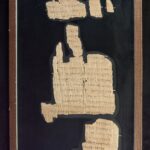| Artefact ID | 837 |
| TM ID | TM 64400 |
| Findspot (DEChriM ID) | - () | Class | Textual |
| Material | Papyrus |
| Writing medium | Codex |
| Text content | Literary |
| Language | Greek |
| Description | P.Beatty XVI; P.ChesterBeatty XVI; MP 02640.100 Papyrus fragments containing the apocryphal work of Iannes et Iambres. The fragments (100 in total, ranging in size from approx 0.3 x 2.5 cm to 10.1 x 16.5 cm) comprise 8 folios (probably of the same quire) from a codex containing Iannes et Iambres. The estimated original size of the folios is approx. 22.5 x 16.2 cm, and presents text written in one column per folio. Binding-holes are visible in several fragments, and indicates a thread binding of the bifolios. The ed. pr., on account of the binding-sequence and the lack of pagination, argues that the codex may have been a product of monastic work in the Western desert, rather than of a literary centre. The hand is described as having an upright, cursive appearance. Supra-linear corrections are made in the same hand. Diaeresis is used sporadically, and the diastole also appears frequently. For punctuation, the scribe employed (more rarely) the mid and high stop. A few Homerisms occur, inter alia εἶλαρ (fra. 2a recto; lines 7 and 13), as well as some tendencies that are common to Classical Greek text, but otherwise not occurring in the Greek of the Septuagint; see ed. pr. Additionally, numbers are written out in full. Another point of interest is the notable forms of the nomina sacra, many of which appear as triliteral contractions or even contractions of 4-6 letters (see abbreviations of ἄνθρωπος in fr. 4c recto l. 3; fr. 4j verso l. 2, fr. 5d verso l. 6, fr. 5h verso l. 7 and fr. 5d recto l. 1) which is similar to contractions in the Acts of Paul in P.Hamb. Bil. 1 (late 3rd/mid 4th c., provenance N/A). |
| Selection criteria | Literary genre (Non-canonical), Nomina sacra |
| Date from | 300 |
| Date to | 399 |
| Dating criteria | Palaeography. The ed. pr. places the fragments no earlier than the lare 3rd or the 4th c., giving the parallel of P.Ryl. III 469 (Letter to the Manicheans from the late 3rd or 4th c., provenance N/A). The fragments were dated to the early 4th c. in private correspondence with E. G. Turner, and to the late 4th or the 5th c. in correspondence with Parsons and Pickering (giving the parallel of P.Rainer Cent. 36 (Philo On virtues from the 5th c.; provenance N/A). |
| Absolute/relative date | Relative date |
| Archaeological context | Provenance is unknown. |
| Accession number | Dublin, Chester Beatty Library P.Bibl. 16. |


 Json data
Json data




